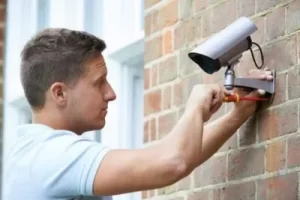Setting up CCTV for Retail Outlets: A Comprehensive Guide

In today’s world, security is a top priority for any business, especially for retail outlets. With the rise of theft and other security concerns, it’s crucial for retail stores to have a reliable surveillance system in place to monitor the premises and keep their customers and employees safe. This is where CCTV (Closed Circuit Television) comes in.
In this article, we will go over the steps to help you set up CCTV for your retail outlet, so you can ensure maximum security and peace of mind.
Step 1: Determine Your Security Needs
The first step in setting up a CCTV system for your retail business is to assess your unique security needs. This involves assessing the size of your shop, the layout of the premises, the locations you want to monitor, and the sort of behavior you want to catch on camera.
For example, you may wish to monitor the cash registers, the entrances and exits, the rear room, and the storage area. This will help you establish the number of cameras you need, their placement, and the sort of cameras that will best meet your needs.
Step 2: Choose the Right Camera
The next step is to pick the proper sort of camera for your retail shop. There are various types of cameras available, including dome cameras, bullet cameras, and PTZ (pan-tilt-zoom) cameras. Each type of camera has its own distinct features and perks, so it’s crucial to pick the perfect one for your purposes.
For example, dome cameras are perfect for monitoring high-traffic areas, such as the front of the store, as they give a large field of view. On the other hand, bullet cameras are perfect for monitoring specific regions, such as the rear room or the storage area. PTZ cameras, on the other hand, are great for large retail shops, since they allow you to control the camera’s movement and zoom in on select regions for a closer look.
Step 3: Determine the Right Placement
Once you’ve picked the proper sort of camera, it’s time to identify the ideal placement for each camera. This includes choosing the proper area to put the camera, as well as establishing the optimum angle to capture the needed video.
For example, you may wish to install the camera in a corner or on the ceiling, and direct it towards the cash registers or the entrance/exit. It’s crucial to ensure that the cameras are positioned in a way that gives maximum coverage of the areas you wish to watch, while still being inconspicuous enough to not bother customers or staff.
Step 4: Install the CCTV System
The next stage is to install the CCTV system. This comprises connecting the cameras to a DVR (digital video recorder) or NVR (network video recorder), and setting up the system software.
It’s crucial to ensure that the cameras are securely installed and the wiring is appropriately disguised to avoid tampering or damage. You should also verify that the DVR or NVR is safely housed in a secure area, such as a locked cabinet or closet.
Step 5: Test and Monitor the CCTV System
Finally, it’s necessary to test the CCTV system to make sure everything is operating properly. This involves assessing the video quality, the camera positioning, and the general performance of the device.
Once the CCTV system is set up and running smoothly, it’s necessary to frequently review the footage to ensure the cameras are catching the appropriate footage. You should also undertake regular maintenance and upgrades, as needed, to keep the system in top functioning condition.
Overview of different types of cameras
There are several types of cameras that are suitable for use in retail outlets, including:
- Dome cameras: These cameras are typically small and discreet, making them well-suited for use in retail environments. They often come with a clear or tinted dome that protects the camera from tampering or damage.
- Bullet cameras: These cameras are cylindrical in shape and often have a longer range of vision than dome cameras. They can be mounted on walls or ceilings and are a popular choice for retail outlets.
- Pan-Tilt-Zoom (PTZ) cameras: These cameras have the ability to pan, tilt, and zoom, allowing the operator to remotely control the camera’s view. This makes them a good choice for monitoring large areas in a retail outlet.
- Hidden cameras: These cameras are designed to be concealed, making them well-suited for use in retail environments where visible cameras may not be desirable.
- Network cameras: These cameras use Wi-Fi or Ethernet to transmit video directly to a network, allowing for remote viewing and management of the footage.
Factors to consider when choosing cameras
Each type of camera has its own unique features and benefits, and the best choice for a retail outlet will depend on the specific needs and requirements of the location.
It’s important to consider the lighting conditions in the retail outlet when choosing cameras. Some cameras are better suited to low light conditions, while others are designed to perform best in well-lit environments. It’s also important to consider the resolution of the cameras, as higher resolution cameras will provide clearer, more detailed footage.
Another factor to consider is the size and layout of the retail outlet. For large or multi-level retail spaces, multiple cameras may be necessary to provide comprehensive coverage. In these cases, it may be necessary to choose cameras with a wider field of view, or to use PTZ cameras to cover multiple areas with a single device.
It’s also important to consider the storage requirements for the footage captured by the cameras. Some cameras come with built-in storage, while others require an external storage solution. The amount of storage required will depend on the amount of footage that is being captured and the length of time that it needs to be retained.
Finally, it’s important to consider the cost of the cameras and any additional equipment or software that may be necessary for their installation and operation. Retail outlets with a limited budget may need to choose less expensive cameras, or opt for a simpler system that includes only the most essential components.
